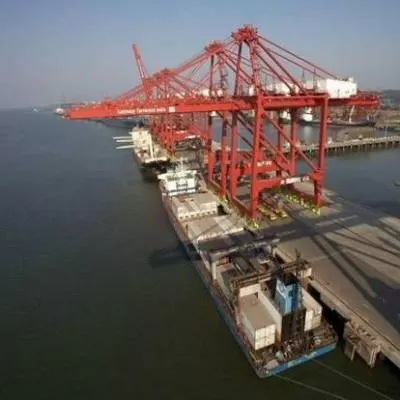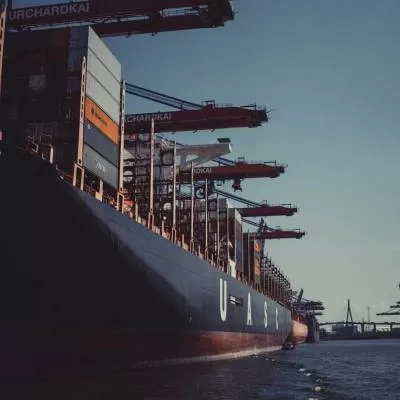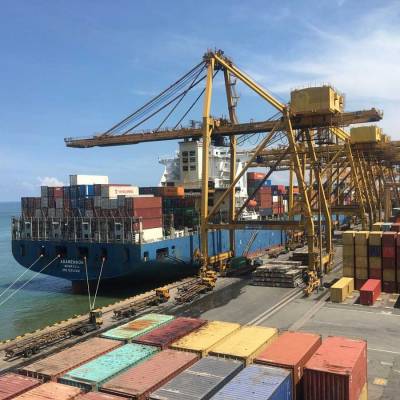- Home
- Infrastructure Transport
- PORTS & SHIPPING
- Housing for Everyman
Housing for Everyman
In the fifth of a series of interviews with prominent engineers, Janaki Krishnamoorthi meets DR Hadadare, General Manager (Engineering), Shivshahi Punarvasan Prakalp Ltd (SPPL), and Chief Engineer/State Nodal Officer for schemes under Jawaharlal Nehru National Urban Renewal Mission (JNNURM), and Maharashtra Housing and Area Development Authority (MHADA).
For the past three decades, DR Hadadare has been breathing, thinking and living low-cost housing. It’s only natural for a man who, except for a short stint in teaching, has spent his entire career at MHADA, an agency involved largely in building homes and infrastructure facilities for the economically weaker sections of society. And beyond the call of duty, his own penchant for working for the needy has made it all worthwhile for him, says Hadadare, who joined MHADA as executive engineer in 1980 and rose to become its chief engineer in 1997. During his tenure he has planned, supervised and executed a variety of schemes including housing for economically weaker sections (EWS), lower income groups (LIG), higher income groups (HIG), slum rehabilitation, Bidi workers, repairs and reconstruction of old buildings and chawls, and providing basic facilities like toilets, potable water, pathways, street lights and sanitation in slums.
“From inception to March 2010, MHADA has built over 6 lakh tenements of varying nature, of which around 2.5 lakh are in Mumbai,” informs 58 year-old Hadadare who hails from Sangli. “The basic challenges before MHADA for most of these schemes have been the same: how to implement the programmes at a low cost without compromising on quality and how to cross-subsidise them.” Up to 80 per cent of houses constructed by MHADA cater to EWS and LIG; MIG and HIG houses are built largely to cross-subsidise the ones built under EWS and LIG.
Though Hadadare retired in September 2010, the government immediately appointed him general manager (engineering) SPPL and chief engineer/state nodal officer for JNNURM schemes being executed by MHADA. Apart from handling ongoing slum rehabilitation projects at SPPL, Hadadare is currently supervising two major housing programmes under JNNURM: Basic Services to Urban Poor (BSUP) being executed in bigger towns like Thane, Nasik and Pune, and Integrated Housing and Slum Development Programme (IHSDP) in smaller towns. In addition, he will be involved in the Central Government’s Rajiv Awaz Yojna (RAY) under JNNURM, an extension of IHSDP/BSUP that aims to create a slum-free India. Hadadare, who will be coordinating the planning and implementation in Maharashtra, is ready for this latest challenge in an illustrious career. He shares his views on this, and much more, in a conversation with CW....
- IHSDP and BSUP schemes: Basically it is a housing scheme for slum dwellers launched four years ago being implemented by local bodies like municipal corporations. MHADA is the nodal agency coordinating the project. Three lakh houses have been approved under this scheme, of which 35,000 have been completed and allotted, some are underway and some are yet to be launched. The project cost is Rs 9,000 crore, of which around Rs 5,000 crore is being provided by the Central Government and the rest is shared by the state government, local bodies and the beneficiary (slum dweller) whose contribution will be 10 per cent of the total cost of the house. The slum dweller, who is also involved in the planning, gets a 25 sq m house with a living room, bedroom, kitchen and toilet. The houses in the majority of cases are being constructed in the same place where the slums are located.
- Rajiv Awas Yojna: This scheme is still in the planning stage and preliminary work like surveys, identification of cities for the project and modalities of implementation are underway. There will be different kinds of schemes with perhaps the state government providing the land and the Central Government giving the funds for development of common infrastructure while the actual construction of the houses may be done with private participation. The exact modus operandi is yet to be finalised.
- Long-term solution to slums: Slums are growing in every urban city in India and the increase in population in these areas is largely in slums. Hence, if we do not provide them housing and amenities they will become a nuisance to others. The day is not far when 90 per cent of the Indian population will be in slums-will they listen to the other 10 per cent like you and me? A solution has to be found. At the same, it is not viable for the government to keep pumping in money to provide free or subsidised houses. Giving free houses is not economically viable everywhere. It has been successful to some extent in Mumbai because the sale component can absorb the cost of free houses. But in other cities we cannot sell the flats at the rates we are selling in Mumbai. Even in Mumbai, where 10 lakh families are living in slums, we have been able to provide housing only for 1 lakh in the past 20 years. Hence, there has to be a sustainable model that can work across the country. And there has to be a variety of solutions-the slum dwellers should be given the option to choose. The government can provide a soft loan and ask them to construct their houses. If they do not wish to construct new houses, then let’s assist them in improving their existing houses with some amenities. In fact, Rajiv Awaz Yojna is likely to be based on all these principles.
- Modern technology in low cost housing: The use of modern technology in low-cost housing does help save on labour and cost to some extent. Wherever possible, MHADA has used modern technology. For instance, in some of our schemes in Pune and Nasik, we use Mivan technology, which has resulted in a quality product. The carpet area also increases as these prefabricated walls are thinner. The use of such technology also eliminates plastering, concreting and human errors and reduces recurring cost of maintenance. Projects get completed faster. But saving on cost of construction per se depends on volumes. If volumes are low, costs can be higher compared to cost of construction using traditional methods. But if we construct around 5,000 houses at one site, cost of construction comes down by almost 20 per cent.
- Redevelopment of old chawls: There are around 17,000 old chawls still under MHADA’s care where around 20 lakh people are staying. Many of them are 70 to 90 years old and in a dilapidated condition owing to non-maintenance. Redevelopment is the only solution but the major obstacle is finding alternate accommodation for occupants during this phase. First, we do not have sufficient transit camps. Second, all the camps are in the suburbs and residents who have lived in South Mumbai for decades and work there are reluctant to move. They are also uncomfortable about living in camps; they feel these are below their present living standards.
- Redevelopment of old MHADA colonies: MHADA has 5,000 acre in 56 colonies across Mumbai, from Vikhroli, Ghatkopar, Kurla and Chembur to Bandra, Andheri and Juhu. These buildings have also become old and the government has sanctioned higher FSI for their redevelopment. Apart from providing present occupants with new, larger homes, redevelopment will also create more housing stock. But here there is a problem getting consent from 70 per cent of the occupants and finding a reliable developer. Residents can also ask MHADA to redevelop but they prefer a private developer as he offers more area depending on location, corpus fund and rent for alternate accommodation during development. MHADA cannot do this as we have to be uniform in our offers and sell the additional flats at an affordable price unlike a developer who can sell at any price. Still, some redevelopments have been taking place in colonies like Tilak Nagar and DN Nagar. But they are largely individual buildings. Instead, residents should join together and go for cluster development. Then they can negotiate better terms with developers, get more area, amenities and a larger corpus fund.
Track record:
• BE (Civil) from Walchand College of Engineering, Sangli (1975)
• ME (Civil) from Walchand College of Engineering, Sangli (1980)
• Underwent special training at University of London on housing policy and affordable housing (1988)
• Lecturer at College of Engineering, Goa (appointed through Union Public Service Commission) (1975-1980)
• Joined MHADA in 1980 as executive engineer; became chief engineer in 1997; retired in September 2010
• Immediately thereafter appointed as chief engineer and state nodal officer for schemes under JNNURM and general manager (engineering), SPPL
Challenging projects
Project: Housing for mill workers (total planning and supervision)
Location: Ten different locations in Mumbai including Lalbaug, Prabhadevi, Sewri, Lower Parel, Kurla, Kandivili
Period: 2008-March 2011
Cost: Rs 860 crore (Rs 250 crore funded by Central Government)
Implemented under: JNNURM
Features: 12,000 houses are to be built, with two-thirds to be allotted to mill workers and one-third to be used for transit camps. “Mill land is spread across 600 acre covering 58 mills, largely in South Mumbai and some suburbs,” explains Hadadare. “Originally MHADA was to get one-third of the total area to build houses for weaker sections and mill workers who lost their jobs. But subsequent to mill owners’ representation and a court ruling, the government decided that one-third of the vacant mill land adjoining the constructed area (instead of the entire land) would be given to MHADA. Thus MHADA finally got only around 30 acre instead of 200 acre.” To make up for the short fall, the government granted 4 FSI and decided to construct high rises ranging from seven floors to 24 floors to have a larger housing stock. As of today, 10,169 flats with modern amenities are almost ready.
Challenges: It is the first time MHADA had built high rises for low-cost housing. As costs go up for high-rise buildings, it had to find ways to keep them low without compromising on quality. Prefabricated technology was used to ensure quality and save on labour and time. “The biggest challenge now for the government and us is to decide the eligibility criteria for the allotment and the workers’ contribution towards the housing,” adds Hadadare. MHADA has so far received 19,000 applications, some of them from the children of deceased mill workers seeking allotment of the houses.
Project: Site and services (total planning and part execution)
Location: Charkop, Mumbai
Period: 1985-1990
Cost: Rs 250 crore
Features: MHADA developed the site with roads, drainage, water supply, open spaces and toilets, and each plot up to plinth level. A World Bank loan was availed to develop these basic facilities. Each plot was then sold at Rs 8,000. The purchasers had to build a one-room tenement in an area of 25 sq m at their cost. MHADA also arranged a loan for 20,000 purchasers. In total, 49,000 ground floor structures were planned with provision for expansion horizontally or vertically. “We called them ‘growing houses’,” says Hadadare. “The idea was to allow owners to add more rooms either by the side or on top with their growing need for more space when the family expanded. Now, many have converted their houses into ground-plus-one structures. They can expand further if they wish by coming together in groups of 25 or more and go for multi-storeyed structures as they can avail of 2.5 FSI now.”
Challenges: To plan the space efficiently for houses and amenities for immediate use and for future expansion either singly or in groups.
In the fifth of a series of interviews with prominent engineers, Janaki Krishnamoorthi meets DR Hadadare, General Manager (Engineering), Shivshahi Punarvasan Prakalp Ltd (SPPL), and Chief Engineer/State Nodal Officer for schemes under Jawaharlal Nehru National Urban Renewal Mission (JNNURM), and Maharashtra Housing and Area Development Authority (MHADA). For the past three decades, DR Hadadare has been breathing, thinking and living low-cost housing. It’s only natural for a man who, except for a short stint in teaching, has spent his entire career at MHADA, an agency involved largely in building homes and infrastructure facilities for the economically weaker sections of society. And beyond the call of duty, his own penchant for working for the needy has made it all worthwhile for him, says Hadadare, who joined MHADA as executive engineer in 1980 and rose to become its chief engineer in 1997. During his tenure he has planned, supervised and executed a variety of schemes including housing for economically weaker sections (EWS), lower income groups (LIG), higher income groups (HIG), slum rehabilitation, Bidi workers, repairs and reconstruction of old buildings and chawls, and providing basic facilities like toilets, potable water, pathways, street lights and sanitation in slums. “From inception to March 2010, MHADA has built over 6 lakh tenements of varying nature, of which around 2.5 lakh are in Mumbai,” informs 58 year-old Hadadare who hails from Sangli. “The basic challenges before MHADA for most of these schemes have been the same: how to implement the programmes at a low cost without compromising on quality and how to cross-subsidise them.” Up to 80 per cent of houses constructed by MHADA cater to EWS and LIG; MIG and HIG houses are built largely to cross-subsidise the ones built under EWS and LIG. Though Hadadare retired in September 2010, the government immediately appointed him general manager (engineering) SPPL and chief engineer/state nodal officer for JNNURM schemes being executed by MHADA. Apart from handling ongoing slum rehabilitation projects at SPPL, Hadadare is currently supervising two major housing programmes under JNNURM: Basic Services to Urban Poor (BSUP) being executed in bigger towns like Thane, Nasik and Pune, and Integrated Housing and Slum Development Programme (IHSDP) in smaller towns. In addition, he will be involved in the Central Government’s Rajiv Awaz Yojna (RAY) under JNNURM, an extension of IHSDP/BSUP that aims to create a slum-free India. Hadadare, who will be coordinating the planning and implementation in Maharashtra, is ready for this latest challenge in an illustrious career. He shares his views on this, and much more, in a conversation with CW.... IHSDP and BSUP schemes: Basically it is a housing scheme for slum dwellers launched four years ago being implemented by local bodies like municipal corporations. MHADA is the nodal agency coordinating the project. Three lakh houses have been approved under this scheme, of which 35,000 have been completed and allotted, some are underway and some are yet to be launched. The project cost is Rs 9,000 crore, of which around Rs 5,000 crore is being provided by the Central Government and the rest is shared by the state government, local bodies and the beneficiary (slum dweller) whose contribution will be 10 per cent of the total cost of the house. The slum dweller, who is also involved in the planning, gets a 25 sq m house with a living room, bedroom, kitchen and toilet. The houses in the majority of cases are being constructed in the same place where the slums are located. Rajiv Awas Yojna: This scheme is still in the planning stage and preliminary work like surveys, identification of cities for the project and modalities of implementation are underway. There will be different kinds of schemes with perhaps the state government providing the land and the Central Government giving the funds for development of common infrastructure while the actual construction of the houses may be done with private participation. The exact modus operandi is yet to be finalised. Long-term solution to slums: Slums are growing in every urban city in India and the increase in population in these areas is largely in slums. Hence, if we do not provide them housing and amenities they will become a nuisance to others. The day is not far when 90 per cent of the Indian population will be in slums-will they listen to the other 10 per cent like you and me? A solution has to be found. At the same, it is not viable for the government to keep pumping in money to provide free or subsidised houses. Giving free houses is not economically viable everywhere. It has been successful to some extent in Mumbai because the sale component can absorb the cost of free houses. But in other cities we cannot sell the flats at the rates we are selling in Mumbai. Even in Mumbai, where 10 lakh families are living in slums, we have been able to provide housing only for 1 lakh in the past 20 years. Hence, there has to be a sustainable model that can work across the country. And there has to be a variety of solutions-the slum dwellers should be given the option to choose. The government can provide a soft loan and ask them to construct their houses. If they do not wish to construct new houses, then let’s assist them in improving their existing houses with some amenities. In fact, Rajiv Awaz Yojna is likely to be based on all these principles. Modern technology in low cost housing: The use of modern technology in low-cost housing does help save on labour and cost to some extent. Wherever possible, MHADA has used modern technology. For instance, in some of our schemes in Pune and Nasik, we use Mivan technology, which has resulted in a quality product. The carpet area also increases as these prefabricated walls are thinner. The use of such technology also eliminates plastering, concreting and human errors and reduces recurring cost of maintenance. Projects get completed faster. But saving on cost of construction per se depends on volumes. If volumes are low, costs can be higher compared to cost of construction using traditional methods. But if we construct around 5,000 houses at one site, cost of construction comes down by almost 20 per cent. Redevelopment of old chawls: There are around 17,000 old chawls still under MHADA’s care where around 20 lakh people are staying. Many of them are 70 to 90 years old and in a dilapidated condition owing to non-maintenance. Redevelopment is the only solution but the major obstacle is finding alternate accommodation for occupants during this phase. First, we do not have sufficient transit camps. Second, all the camps are in the suburbs and residents who have lived in South Mumbai for decades and work there are reluctant to move. They are also uncomfortable about living in camps; they feel these are below their present living standards. Redevelopment of old MHADA colonies: MHADA has 5,000 acre in 56 colonies across Mumbai, from Vikhroli, Ghatkopar, Kurla and Chembur to Bandra, Andheri and Juhu. These buildings have also become old and the government has sanctioned higher FSI for their redevelopment. Apart from providing present occupants with new, larger homes, redevelopment will also create more housing stock. But here there is a problem getting consent from 70 per cent of the occupants and finding a reliable developer. Residents can also ask MHADA to redevelop but they prefer a private developer as he offers more area depending on location, corpus fund and rent for alternate accommodation during development. MHADA cannot do this as we have to be uniform in our offers and sell the additional flats at an affordable price unlike a developer who can sell at any price. Still, some redevelopments have been taking place in colonies like Tilak Nagar and DN Nagar. But they are largely individual buildings. Instead, residents should join together and go for cluster development. Then they can negotiate better terms with developers, get more area, amenities and a larger corpus fund. Track record: • BE (Civil) from Walchand College of Engineering, Sangli (1975)• ME (Civil) from Walchand College of Engineering, Sangli (1980)• Underwent special training at University of London on housing policy and affordable housing (1988)• Lecturer at College of Engineering, Goa (appointed through Union Public Service Commission) (1975-1980)• Joined MHADA in 1980 as executive engineer; became chief engineer in 1997; retired in September 2010• Immediately thereafter appointed as chief engineer and state nodal officer for schemes under JNNURM and general manager (engineering), SPPL Challenging projects Project: Housing for mill workers (total planning and supervision)Location: Ten different locations in Mumbai including Lalbaug, Prabhadevi, Sewri, Lower Parel, Kurla, KandiviliPeriod: 2008-March 2011Cost: Rs 860 crore (Rs 250 crore funded by Central Government) Implemented under: JNNURMFeatures: 12,000 houses are to be built, with two-thirds to be allotted to mill workers and one-third to be used for transit camps. “Mill land is spread across 600 acre covering 58 mills, largely in South Mumbai and some suburbs,” explains Hadadare. “Originally MHADA was to get one-third of the total area to build houses for weaker sections and mill workers who lost their jobs. But subsequent to mill owners’ representation and a court ruling, the government decided that one-third of the vacant mill land adjoining the constructed area (instead of the entire land) would be given to MHADA. Thus MHADA finally got only around 30 acre instead of 200 acre.” To make up for the short fall, the government granted 4 FSI and decided to construct high rises ranging from seven floors to 24 floors to have a larger housing stock. As of today, 10,169 flats with modern amenities are almost ready.Challenges: It is the first time MHADA had built high rises for low-cost housing. As costs go up for high-rise buildings, it had to find ways to keep them low without compromising on quality. Prefabricated technology was used to ensure quality and save on labour and time. “The biggest challenge now for the government and us is to decide the eligibility criteria for the allotment and the workers’ contribution towards the housing,” adds Hadadare. MHADA has so far received 19,000 applications, some of them from the children of deceased mill workers seeking allotment of the houses. Project: Site and services (total planning and part execution)Location: Charkop, Mumbai Period: 1985-1990Cost: Rs 250 crore Features: MHADA developed the site with roads, drainage, water supply, open spaces and toilets, and each plot up to plinth level. A World Bank loan was availed to develop these basic facilities. Each plot was then sold at Rs 8,000. The purchasers had to build a one-room tenement in an area of 25 sq m at their cost. MHADA also arranged a loan for 20,000 purchasers. In total, 49,000 ground floor structures were planned with provision for expansion horizontally or vertically. “We called them ‘growing houses’,” says Hadadare. “The idea was to allow owners to add more rooms either by the side or on top with their growing need for more space when the family expanded. Now, many have converted their houses into ground-plus-one structures. They can expand further if they wish by coming together in groups of 25 or more and go for multi-storeyed structures as they can avail of 2.5 FSI now.”Challenges: To plan the space efficiently for houses and amenities for immediate use and for future expansion either singly or in groups.
























